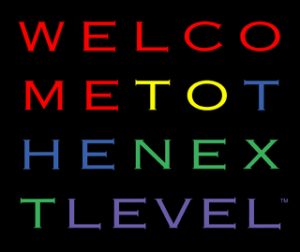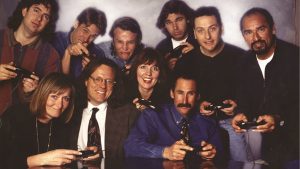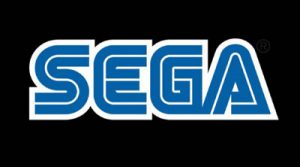 It takes a combination of things to make a product successful. On the one hand, what’s being sold has to be innovative and interesting. On the other, it also has to be desirable. The best products never leave the shelves if the public doesn’t want them, and that’s where good marketing comes in. It takes a creative and focused team to make people want to buy what they’re selling.
It takes a combination of things to make a product successful. On the one hand, what’s being sold has to be innovative and interesting. On the other, it also has to be desirable. The best products never leave the shelves if the public doesn’t want them, and that’s where good marketing comes in. It takes a creative and focused team to make people want to buy what they’re selling.
David O’Hare knows how to sell things. He’s been doing it for over three decades, and and he’s been involved with many popular advertising campaigns for the NBA and General Motors. As a member of the team at the Goodby, Berlin & Silverstein (now Goodby, Silverstein & Partners) advertising agency, he turned the Sega Genesis from an upstart console into the video game product everyone wanted. Goodby’s “WELCOME TO THE NEXT LEVEL” campaign, along with the legendary “Sega Scream,” turned Sega into a major consumer powerhouse and gave it the edge it needed to finally break Nintendo’s monopoly on the industry.
Recently, Mr. O’Hare chatted with us about how this famous marketing tactic changed video games forever.
Sega-16: How did Goodby, Berlin & Silverstein get the Sega account?
David O’Hare: It’s funny. Way back when we were first considering pitching the account – you have to remember that Goodby… we were a tiny little shop. I think at that time, Sega would have been our biggest account. You get these things called “RFPs” (Request for Proposal). It’s this big, long questionnaire that clients put out to agencies. They want to know about how you would staff the account, all in this multi-page questionnaire. We thought, “Holy shit! You know what? We’ll fill out the RFP, but we should have a kid deliver it.” We knew, even from the get-go, that Sega was all about kids; it was all about gamer kids. The fewer adults that were involved in the process, the better. So, we thought that we should have a kid deliver the RFP to Sega because they were just down in Redwood City.
 At that time, not a lot of people at Goodby had kids. Jeff Goodby and Rich Silverstein had kids, and I had a son, Flynn. He was probably seven or eight at the time. We decided to have Flynn deliver the RFP down there. We got a limousine to take him down there, and we told him to go into the lobby and ask for someone (Ed. Note: possibly former Group President Doug Glenn) and tell them he was from Goodby and that he was there to drop off the RFP. So, here’s this little eight-year-old kid who walks into the lobby and gives the message. This guy comes out, and my son gives him the stuff. As Flynn turns to leave, the guy goes, “Hey, you like video games? Follow me.” He takes my son out of the lobby and down this hallway to this locked room that’s filled with Game Gears, Genesis machines, and probably every game that Sega made. The man tells Flynn, “Whatever you can carry, you can keep.” Flynn loads up on all this stuff, and he comes back to the agency. We asked him if he delivered the document, and he goes, “Yeah! Look at all this stuff! And he let me go back!” (laughs).
At that time, not a lot of people at Goodby had kids. Jeff Goodby and Rich Silverstein had kids, and I had a son, Flynn. He was probably seven or eight at the time. We decided to have Flynn deliver the RFP down there. We got a limousine to take him down there, and we told him to go into the lobby and ask for someone (Ed. Note: possibly former Group President Doug Glenn) and tell them he was from Goodby and that he was there to drop off the RFP. So, here’s this little eight-year-old kid who walks into the lobby and gives the message. This guy comes out, and my son gives him the stuff. As Flynn turns to leave, the guy goes, “Hey, you like video games? Follow me.” He takes my son out of the lobby and down this hallway to this locked room that’s filled with Game Gears, Genesis machines, and probably every game that Sega made. The man tells Flynn, “Whatever you can carry, you can keep.” Flynn loads up on all this stuff, and he comes back to the agency. We asked him if he delivered the document, and he goes, “Yeah! Look at all this stuff! And he let me go back!” (laughs).
That’s kind of how it began. It was the biggest account we were ever going to pitch, and we were pitching against Wieden + Kennedy, who are up in Portland.
Sega-16: Was this your first experience marketing video games?
David O’Hare: It was mine, yeah. It was the agency’s, and I don’t think anyone there had worked on video games. We didn’t know what the rules were, and if there were rules, we didn’t care about them.
Well, I shouldn’t say that no one had any video game experience. That’s not true. I didn’t have any, most of the creative people that worked on it probably didn’t. Jeff and Rich did, I think when they had just started the agency, coming from Hal Riney & Partners, or maybe even as a freelance thing they were doing on the side. They helped Trip Hawkins launch Electronic Arts, and it was interesting in that the approach they took was all about the game designers. I can remember Rich had a photo in his office, and I can’t remember who shot it. It might have been the famous rock photographer Jim Marshall, but they shot this black and white picture of this group of designers and developers. They shot them like they were rock stars. It was really heroic and really cool, and it had a lot of attitude. You have to remember; this was the early ‘80s. it was this kind of badass group of coders and designers. Man, they looked like freakin’ rock stars! That’s how they presented them. I think that might have been one of the first forays into elevating games and the people who made them.
With Sega, we took the gamers themselves. We assumed that they had a reasonable amount of intelligence, and we never talked down to them. We always made the stuff just challenging enough so that the really good ones could figure it out.
Sega-16: That’s understandable. Video games were an established industry, but there still wasn’t a reliable marketing process. Video games aren’t like shampoo, which you can market the same way for decades. A company that’s on top one generation could be dead last in the next. Each new hardware cycle signifies a restart in how you market your products.
David O’Hare: Exactly. Every spot had to be fresh out of the box; you couldn’t follow any kind of format.
Sega-16: Do you recall how the Sega Scream campaign came about? I’ve read that it wasn’t the first pitch Goodby and Sega came up with.
David O’Hare: Well, the “Sega Scream” and “Welcome to the Next Level” were part of the same campaign. The campaign itself was called “Welcome to the Next Level,” and I actually wrote the tagline based on observations from our planners, Irina Lapin and Jon Steel, who is this brilliant guy and who was sort of the secret weapon in all of our big wins back in those days; strategically, he’s the best. Together, they had basically come up with the strategy that up until then, really the only game in town was Nintendo; they dominated the market. What that meant was that if your parents were going to buy you a video game system, they were going to buy you a “Nintendo.” Even your parents knew about Nintendo, which of course, is the kiss of death to a kid, right? I mean, if your parents know enough to buy you a Nintendo… it was kind of like that old joke that when any fad reaches a McDonald’s commercial, that fad is long gone. Like, as soon as breakdancing found its way into a McDonald’s commercial, breakdancing had been dead for about a year and a half. We sort of joked and said, “Congratulations, your parents are going to buy you a video game system. Now, quick! Stop them because they’re going to buy you a Nintendo!”
The whole idea with Sega was to make it relevant to gamer kids. We set up a whole war room at Goodby in the basement, and we would have kids come in after school and just play video games. We’d watch them, we’d ask them questions, and we’d observe how they interacted with each other and with the games. We realized that to a gamer kid, everything was about getting through a level as quickly as you possibly could to get to the next level of the game. That meant that you knew where all the clues were, and you knew all the secret moves. The more proficient you were, the faster you could move through the game. That’s what the tagline “Welcome to the Next Level” was about, but it also had a double meaning in that it was video game parlance, but it was also saying to kids, “This is the next level in video games, design and all that other stuff. Forget Nintendo. Nintendo was boring, slow, and your parents know about it.”
 So, we created this slogan, and we did it as a puzzle. We would always write it so that it was almost indecipherable. A parent looking at it would look at the puzzle and go, “What does that say?” A gamer kid would look at it and know it said, “Welcome to the Next Level.” They saw it right away. That’s what they do; they decipher clues. We figured we’d make it as unintelligible as we possibly can for an adult, and we were going to make it extremely annoying, loud, fast, and irritating. But to a kid, they’re going to like it because their parents hate it. The more we could get parents to go, “Oh that’s just disgusting! That’s so loud and gross!” the more kids wanted it. So, the parents didn’t like it. That, in a nutshell, is sort of the strategy we used.
So, we created this slogan, and we did it as a puzzle. We would always write it so that it was almost indecipherable. A parent looking at it would look at the puzzle and go, “What does that say?” A gamer kid would look at it and know it said, “Welcome to the Next Level.” They saw it right away. That’s what they do; they decipher clues. We figured we’d make it as unintelligible as we possibly can for an adult, and we were going to make it extremely annoying, loud, fast, and irritating. But to a kid, they’re going to like it because their parents hate it. The more we could get parents to go, “Oh that’s just disgusting! That’s so loud and gross!” the more kids wanted it. So, the parents didn’t like it. That, in a nutshell, is sort of the strategy we used.
Sega-16: As Sega legend goes, the scream came from a worker on the set of the first commercial who suggested that someone scream the company’s name at the end of the ad. Do you know if that’s true?
David O’Hare: In order to get the account, one of things we did was this thing we called an “idea video.” It was kind of a proof-of-concept, kind of a manifesto, if you will, all centered on “Welcome to the Next Level.” We didn’t have a whole lot of money as an agency, you know. When you’re pitching a piece of business, the agency is spending its own money, usually. Very few clients pay for an agency to pitch them business. We didn’t have a lot of money, but we knew that we wanted to make this little two-minute film. We got a bunch of friends together, a cameraman, and some grips and whatnot, and we shot the film ourselves over a weekend. On one of the days, on one of the locations, the sound guy was standing there with his sound boom, in between takes. One of the grips, who I think was somebody’s kid, walked past the sound guy and leaned into his boom and said “SEGA!” He was just messing around, just being a wise ass.
Anyway, we got into the editing room and were cutting this film together with a guy named Hank Corwin, who went on to become Oliver Stone’s editor. Hank is a brilliant, brilliant editor. We got to the end of the film, and the “Welcome to the Next Level” thing came up, and then the Sega logo at the end. We thought it was pretty cool but thought that it was missing something. It needed a punctuation. Either we cut to something… I don’t know. Hank says, “Why don’t you guys go to lunch and let me mess around with it and see what we can do?” We come back from lunch, and Hank says, “Watch this!” He plays the film, and at the end, at the little button, all of a sudden we hear this voice go “SEGA!” He had found that audio in the outtakes, and he just slipped it in there and it worked. I swear to God, we never re-recorded it. I think that kid probably put himself through college off of that, but it was a complete improv… one of those happy accidents that, in retrospect, completely changed video game advertising. It sent it off in a new direction because it wasn’t that far after the Sega stuff began to run and became well-known that PlayStation came out with the “PlayStation” little pneumonic. Suddenly, every video game company had to have like, a little pneumonic that they’d throw up at the end of their spots.
Sega-16: That’s interesting! I wonder, because it’s been written that the Sega Scream that appears in the commercials was done by writer and director Jimbo Matison.
David O’Hare: Oh really? I don’t even know who that is! Maybe it was that kid? (laughs) I have no idea. I just know we found it in the outtakes and it was just one of those great, serendipitous things. How lucky were we that we found it. To this day, I don’t know who it was. Whoever it was leaned into the microphone and shouted it in. It was all distorted and over-modulated… it was just this random act of goofiness. Like I said, we never changed it, never spent money to re-record it so that it sounded better. It was perfect.
It was a cool account to work on, primarily because none of us had ever worked on video game advertising before. Like I said, we didn’t know what the rules were. We didn’t care what the rules were! We just figured we’d see what we could get away with… how much we could get away with, as often as we could.
Editor’s Note. It is possible that the scream recorded for Goodby’s proof-of-concept video was an early version, and that the recording used was never re-recorded for that video. The one used in the commercials may have been recorded by Matison after the campaign was finally approved by Sega.
Always looking to find the story, we contacted Jimbo Matison and asked him!
Jimbo Matison: I worked at the production company, Colossal Pictures, and I knew everyone involved in the whole beginning of that all. Someone mistook the actor in the commercial, who was a grip at Colossal (Doug Kiefer), for being the actual voice. So when the commercial came out, he started getting SAG (Screen Actors Guild) pay from them. He had gotten well over 10K, in fact, when someone else pointed out they were paying the wrong guy. Legally, SAG couldn’t ask for the money back from Doug, and he got a nice trip to Africa with the money. Yay, Doug! I finally got paid for those commercials as well, and the rest is history.
Sega-16: Was Sega open to your ideas? They just let you run with them?
David O’Hare: Well… yes and no. They were pretty conservative, it’s funny. We would often pull into the parking lot down in Redwood City, this kind of corporate building and think to ourselves, “here we are, ladies and gentlemen, the coolest company in America!”
 I think they sort of tolerated us because whatever it was we were doing was working. I’m not sure everybody completely understood why it was working. You know, in marketing, you have to be able to quantify everything, and I’m not sure it was quantifiable. I’m not sure even we knew what we were doing! It was just that the more feedback we got from kids and the gaming community telling us how much they liked it – it had all the irreverence of how gamers saw themselves. You know, they saw themselves as outsiders and mavericks, kind of these rabble-rousers who were bucking he system. That’s kind of how they viewed themselves. It was all about just speaking to that audience. We knew that the minute we got parental approval; we were sunk. (laughs) As soon as the advertising became predictable… it’s like a game. Think about it. The minute you get halfway through a level and realize you know how things work and figure things out, it’s no fun anymore and you stop playing it. You look for the next game that’s going to challenge and surprise you. Really, the advertising was just trying to mirror the experience of gaming itself for these kids.
I think they sort of tolerated us because whatever it was we were doing was working. I’m not sure everybody completely understood why it was working. You know, in marketing, you have to be able to quantify everything, and I’m not sure it was quantifiable. I’m not sure even we knew what we were doing! It was just that the more feedback we got from kids and the gaming community telling us how much they liked it – it had all the irreverence of how gamers saw themselves. You know, they saw themselves as outsiders and mavericks, kind of these rabble-rousers who were bucking he system. That’s kind of how they viewed themselves. It was all about just speaking to that audience. We knew that the minute we got parental approval; we were sunk. (laughs) As soon as the advertising became predictable… it’s like a game. Think about it. The minute you get halfway through a level and realize you know how things work and figure things out, it’s no fun anymore and you stop playing it. You look for the next game that’s going to challenge and surprise you. Really, the advertising was just trying to mirror the experience of gaming itself for these kids.
Sega-16: The Sega Scream was targeted at older Nintendo owners who had “outgrown” their NES consoles and wanted something edgier. It went on to become part of ‘90s popular culture. Did you ever think it would get that big?
David O’Hare: Oh no! No, you never do. You’re just doing your job. It was fun, though! My son grew up, and a number of years back he was studying game design in Arizona. He was taking a course on the history of video games, and I remember he called me up one night to tell me that Sega was a whole chapter in his textbook. He said, “you guys are famous!” I couldn’t believe we were famous for advertising. That’s crazy. But sure enough, he showed it to me, and it was like this whole chapter in this book.
When he told his professor that his dad was one of the guys that did that campaign, he said the guy almost wet his pants! (laughs) They had me come in and talk about it. In a weird kind of way, it really did send that industry in a new direction, and there’s been some really great work since then. For example, the British director Frank Budgen did an ad with the Shirley Temple song “Get on Board” (the famous 2003 PlayStation 2 “Mountain” ad). They shot it in Rio, I think, and it’s a really cool spot.
Sega-16: Do you recall why Goodby’s relationship with Sega ended?
David O’Hare: I don’t. I don’t remember why it ended. I think that like a lot of things, companies rides a piece of business maybe a bit longer than they should, and I think they got beat. They had the 16-bit machine, and then the next one came along, and they were late to take on PlayStation’s marketing. By then, PlayStation was gearing up. It’s pretty hard to go against Sony, and Sega just got outspent and outmaneuvered. I think that caused a lot of cutbacks, and in times like that – and I’m just speculating here – my guess is that when stuff like that happens, they usually bring in a new CMO (Chief Marketing Officer) who usually fires the agency and brings in his own agency and his own people because he’s there to save the day. I’m guessing that’s probably what happened. Sega rose and rose and rose, and suddenly, they weren’t on top anymore.
Sega-16: They actually brought the Sega Scream back a few years after that, for the Dreamcast. It was short-lived, but it was nice to see it back.
David O’Hare: Oh, did they? I don’t remember that. I think I may have already moved on to a different agency by then. (Laughs) Yeah, you know, once you move a piece of business, you kind of lose interest in it pretty quick!
Sega-16: Both Sega campaigns are still fondly remembered by fans today, more than 25 years later. For you personally, where do they stand on your list of accomplishments?
David O’Hare: Well, really the first big international campaign for the NBA was something called “I Love This Game!” that we did. I helped launch the Saturn car company, introduced the first mass-produced electric car, the EV-1, but I don’t know. I mean, I’ve worked on some pretty cool things. I actually worked back in the early days of Macintosh, back in ’84-’85. That’s kind of when I started in the business.
 I mean, it’s up there! I really don’t talk about my work all that much, but I was in New York not all that long ago. Somehow, we were talking about old campaigns we had done, and I had mentioned Sega. This guy who was one of the assistants – must have been in his late ‘20s or early ‘30s – he was in the room, and he turns to me and says, “holy shit! You did that campaign? I loved that campaign! My parents hated it. They found it really annoying.” I said, “good! It worked!” When I asked him what he thought about it, he said that he and his friends thought it was the coolest thing ever. So, I guess it did its job, but I hadn’t really thought about it until I got your email. I’m actually kind of surprised that people still remember it.
I mean, it’s up there! I really don’t talk about my work all that much, but I was in New York not all that long ago. Somehow, we were talking about old campaigns we had done, and I had mentioned Sega. This guy who was one of the assistants – must have been in his late ‘20s or early ‘30s – he was in the room, and he turns to me and says, “holy shit! You did that campaign? I loved that campaign! My parents hated it. They found it really annoying.” I said, “good! It worked!” When I asked him what he thought about it, he said that he and his friends thought it was the coolest thing ever. So, I guess it did its job, but I hadn’t really thought about it until I got your email. I’m actually kind of surprised that people still remember it.
Sega-16: The campaign is such an integral part of Sega’s history of that era. It’s really hard to discuss the period without mentioning it. A great product doesn’t go anywhere without great marketing, and that campaign is what did it.
David O’Hare: Again, Jon and Irina deserve a lot of credit for that. They’re the ones who said that it would be the kiss of death if we came at this as adults. We needed to convince Sega during the pitch that we completely understood the mindset of these kids. During the pitch process, the clients come by the agency every so now and again for meetings, kind of work in progress stuff. They kind of want to feel what it would be like to work with you as an agency. That’s just part of the process.
So, we’d have these meetings, and besides having the war room at the agency, we turned our conference room into a 12-year-old boy’s bedroom, complete with dirty clothes everywhere, food wrappers, posters, basketball shoes, a TV, and a game console. We stylized this whole room so we would have meetings in a kid’s room while we talked about kids and played the games. From that standpoint, it really was a lot of fun to work on. We got to be kids again! We got to do all the stuff we got caught doing the first time and got scolded for, only now we weren’t getting scolded; we were getting rewarded! (laughs)
Sega-16 thanks Mr. O’Hare for taking the time for this interview. For more history on Sega’s tactics for marketing the Genesis, be sure to read our article “Marketing the Genesis: Sega’s Advertising 1981-1996.”
Image of Goodby, Berlin & Silverstein staff originally published in the book “Console Wars.”

Recent Comments